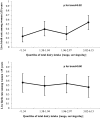Dairy intake in relation to in vitro fertilization outcomes among women from a fertility clinic
- PMID: 26787645
- PMCID: PMC4755446
- DOI: 10.1093/humrep/dev344
Dairy intake in relation to in vitro fertilization outcomes among women from a fertility clinic
Abstract
Study question: Is dairy food consumption associated with live birth among women undergoing infertility treatment?
Summary answer: There was a positive association between total dairy food consumption and live birth among women ≥35 years of age.
What is known already: Dairy food intake has been previously related to infertility risk and measures of fertility potential but its relation to infertility treatment outcomes are unknown.
Study design, size, duration: Our study population comprised a total of 232 women undergoing 353 in vitro fertilization (IVF) treatment cycles between February 2007 and May 2013, from the Environment and Reproductive Health study, an ongoing prospective cohort.
Participants/materials, setting, methods: Diet was assessed before assisted reproductive technology (ART) treatment using a validated food frequency questionnaire. Study outcomes included ovarian stimulation outcomes (endometrial thickness, estradiol levels and oocyte yield), fertilization rates, embryo quality measures and clinical outcomes (implantation, clinical pregnancy and live birth rates). We used generalized linear mixed models with random intercepts to account for multiple ART cycles per woman while simultaneously adjusting for age, caloric intake, BMI, race, smoking status, infertility diagnosis, protocol type, alcohol intake and dietary patterns.
Main results and the role of chance: The age- and calorie-adjusted difference in live birth between women in the highest (>3.0 servings/day) and lowest (<1.34 servings/day) quartile of dairy intake was 21% (P = 0.02). However, after adjusting for additional covariates, this association was observed only among women ≥35 years (P, interaction = 0.04). The multivariable-adjusted live birth (95% CI) in increasing quartiles of total dairy intake was 23% (11, 42%), 39% (24, 56%), 29% (17, 47%) and 55% (39, 69%) (P, trend = 0.02) among women ≥35 years old, and ranged from 46 to 54% among women <35 years old (P, trend = 0.69). There was no association between dairy intake and any of the intermediate outcomes.
Limitations, reasons for caution: The lack of a known biological mechanism linking dairy intake to infertility treatment outcomes calls for caution when interpreting these results and for additional work to corroborate or refute them.
Wider implications of the findings: Dairy intake does not appear to harm IVF outcomes and, if anything, is associated with higher chances of live birth.
Study funding/competing interests: This work was supported by NIH grants R01-ES009718 and R01ES000002 from NIEHS, P30 DK046200 from NIDDK and T32HD060454 from NICHD. M.C.A. was supported by a Ruth L. Kirschstein National Research Service Award T32 DK 007703-16 from NIDDK. She is currently employed at the Nestlé Research Center, Switzerland and completed this work while at the Harvard School of Public Health. The other authors declare no conflicts of interest.
Keywords: assisted reproductive technology; dairy; diet; in vitro fertilization outcomes; live birth rate.
© The Author 2016. Published by Oxford University Press on behalf of the European Society of Human Reproduction and Embryology. All rights reserved. For Permissions, please email: journals.permissions@oup.com.
Figures

References
-
- Bandyopadhyay S, Chakrabarti J, Banerjee S, Pal AK, Goswami SK, Chakravarty BN, Kabir SN. Galactose toxicity in the rat as a model for premature ovarian failure: an experimental approach readdressed. Hum Reprod 2003;18:2031–2038. - PubMed
-
- Chandra A, Copen CE, Stephen EH. Infertility service use in the United States: data from the National Survey of Family Growth, 1982-2010. Natl Health Stat Rep 2014;73:1–21. - PubMed
-
- Chavarro JE, Rich-Edwards JW, Rosner B, Willett WC. A prospective study of dairy foods intake and anovulatory infertility. Hum Reprod 2007;22:1340–1347. - PubMed
-
- Cramer DW, Xu H, Sahi T. Adult hypolactasia, milk consumption, and age-specific fertility. Am J Epidemiol 1994;139:282–289. - PubMed
Publication types
MeSH terms
Grants and funding
LinkOut - more resources
Full Text Sources
Other Literature Sources
Medical
Research Materials

